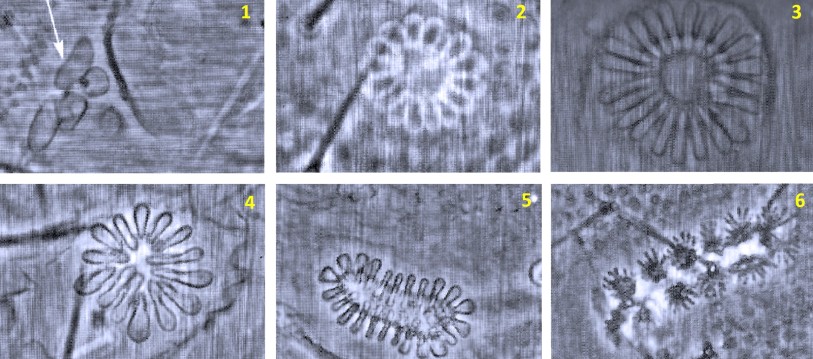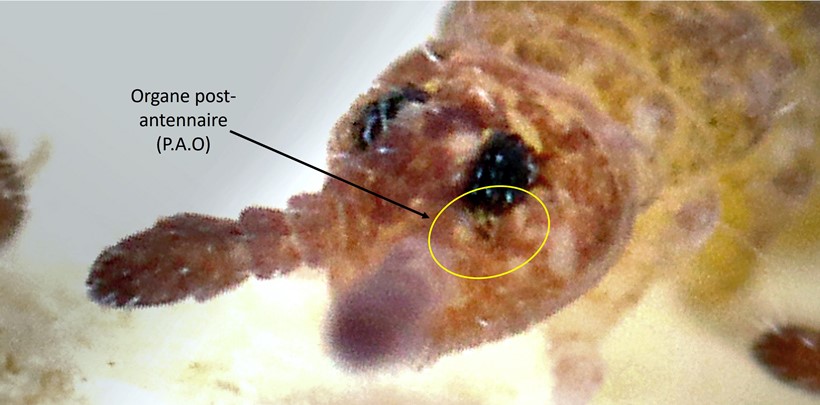The postantennal organ or "PAO" (Post Antennal Organ) is a chemoreceptor sensory organ found in some springtails. However, families like the Entomobryidae do not have it and, for example, in some Sminthurididae, this organ takes the form of a small bulb shaped like an ankle. In Tomoceridae, Steve.P. Hopkin1 notes that some springtails can be endowed with them during their juvenile stage, although this is not the case for all species. The absence of PAO even led scientists to deduce that this organ was not vital for springtail.
The structure of PAO has long been an important taxonomic criterion (especially in Onychiuridae) but in other families it also presents a diversity of shape or location.

The illustration above shows PAO in three distinct families.
From left to right: Odontellidae (Superodontella lamellifera), Isotomidae (Isotomurus maculatus), Onychiuridae (Kalaphorura burmeisteri).
It can be noted that on this last family (Onychiuridae), the PAO consists of a rosette which stretches in length and which bears at least thirty smooth or lobed protuberances arranged in an elongated groove, whereas in the Isotomidae, the PAO is an oval or horn-shaped cuticular plate elevated above the surrounding cuticular surface. In Hypogastrura socialis, the PAO takes on the appearance of a four-lobed protuberance located in a shallow pit.
Regarding the diversity of PAOs, it can be said that the shape and appearance of this organ differ significantly between families, although its internal structure remains the same within a given family.
The post-antennal organ is generally made up of a system of tiny pores (between 5 and 10 nanometers) organized on a single sensory cell, with branched external hair segments, connected to the central nervous system. These pores (image below2) have an olfactory function and very probably also play the role of thermal and hygrometric probe.
 In another book3 which takes up the keys to identifying species, Steve P. Hopkin offers plates on PAO which underline their differentiating elements. The photo montage below, made from this document, shows a preview. It can be noted that illustrations 2, 3, 4 and 5 are taken from PAO of four distinct species belonging to the same family (Neanuridae).
In another book3 which takes up the keys to identifying species, Steve P. Hopkin offers plates on PAO which underline their differentiating elements. The photo montage below, made from this document, shows a preview. It can be noted that illustrations 2, 3, 4 and 5 are taken from PAO of four distinct species belonging to the same family (Neanuridae).
 1.Ceratophysella denticulata (Hypogastruridae) - 2. Anurida thalassophila, 3.Anuridella marina, 4.Anurida granaria, 5.Annurida tullbergi (Neanuridae) - 6.Deuteraphorura inermis (Onychiuridae).
1.Ceratophysella denticulata (Hypogastruridae) - 2. Anurida thalassophila, 3.Anuridella marina, 4.Anurida granaria, 5.Annurida tullbergi (Neanuridae) - 6.Deuteraphorura inermis (Onychiuridae).
Although all of its functions are not yet fully understood, researchers who have powerful means of investigation (DNA sequencing, scanning electron microscopes, chromatography, etc.) are now able to better understand them.
For example, a study4 which falls within the framework of the enrichment of the “COLTRAIT” database (PDF click here), aiming to link the morphological features of springtails to the characteristics of the environment in which they evolve, shows, in Regarding PAO, that its presence or absence seems associated with two traits, according to a particular model:
- Presence of PAO ⇒ Short antennas.
- Lack of PAO / long furca ⇒ long antennas.
Note: Aware of being very reductive in my plot restitution of this study, I will not dwell, in fact, on the criteria relating to the qualification of the samples studied or the consideration of many prerequisites allowing to obtain results. significant. I will simply take three short extracts from it to shed some light on the part of its conclusions relating to the PAO.
"When selecting a group of species on the basis of their representativeness in a given environment, the species found mainly in closed environments are characterized by an absence of PAO and a 'short' or absent furca. Conversely, the relative length of the antennae does not seem to come into play in the characterization of species relative to the level of closure of their environment ".

The investigations therefore made it possible to highlight the importance of PAO in the characterization of communities, depending on the level of openness or closure of the environment and to establish for the species studied a correlation between the number of PAO lobes and the opening of the environment in which these springtails evolve
"The open environment being a more changeable environment (humidity, temperature etc.), PAO could then be an asset in the perception of these unfavorable / favorable changes and allow the individual to move accordingly".
Besides the openness level of a medium, the depth factor can also be correlated with some other morphological adaptations such as the size or level of development of the furca, antennae, and visual organs.
"The characters supposed to allow adaptation to the open environment, that is to say a rapid movement and numerous sensory organs to capture the larger environmental variations (long furca, long antennae, PAO) are also those which condition a mode of epigee life5 ”.
Regarding the olfactory* capacities of springtail, it is reasonable to assume that PAO chemoreceptors may play a role, along with other organs, such as the antennal organs (see the right image of the illustration at the beginning of the article which shows the two antenna organs "OA3").
* These will soon be the subject of an upcoming article on this same site.
Sources :
1. " Biology of the springtails "
2. Montage effectué d’après images d’un Archisotoma sp. Par R.Jordan et E.Baquero.
3. "A key to the Collembola (Springtails) of Britain and Ireland" :https://www.field-studies-council.org/shop/publications/springtails-aidgap/
4. Enrichissement de la Base de donnees COLTRAIT
5. The "epigee" environments are located immediately under the herbaceous layer, on the surface of the soil or a natural substrate such as dead leaves.